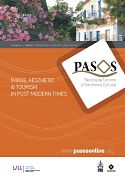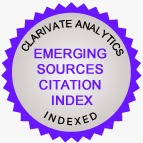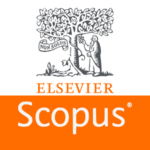Imagem de destino, imagem no destino. Aspectos metodológicos
DOI:
https://doi.org/10.25145/j.pasos.2013.11.041Palavras-chave:
imagem de destino, hibridização cultural, motivação, processo decisórioResumo
Hoje, o papel desempenhado pela imagem no desenvolvimento do turismo e, especialmente, como elemento de diferenciação de uma área de destino é amplamente reconhecido. Isso se reflete em grande parte na literatura que foca seu interesse na identificação das variáveis que motivam a compra ou estimulam o processo de decisão. Entretanto, a referência a processos de feedback ou mecanismos de controle de imagem, bem como a sua criação, é surpreendente. Um modelo de abordagem para estes processos será exposto neste artigo.
Downloads
##plugins.generic.pfl.publicationFactsTitle##
##plugins.generic.pfl.reviewerProfiles## Indisp.
##plugins.generic.pfl.authorStatements##
##plugins.generic.pfl.indexedIn##
-
##plugins.generic.pfl.indexedList##
- ##plugins.generic.pfl.academicSociety##
- PASOS. Revista de Turismo y Patrimonio Cultural
- ##plugins.generic.pfl.publisher##
- Instituto Universitario de Investigación Social y Turismo. Universidad de La Laguna (España) - Instituto Universitario da Maia ISMAI (Portugal)
Referências
Agarwal, S. 2006 “Coastal Resort Restructuring and the TALC Model”. In R. W. Butler. The tourism area life cycle: conceptual theoretical Issues. Clevedon, Channel View Publications: 201-218.
Andreu, L.; Bigné, J.E. and Cooper, C. 2000 “Projected and perceived image of Spain as a tourist destination for british travelers”. Journal of Travel & Tourism Marketing, 9(4): 47 - 67.
Assael, H. 1984 Consumer behavior and marketing action. Boston: Kent Publishing.
Awang, K.W.; Wan Hassan, W.M. & Mohd Zahari, M.S. 2009 “Tourism development: A geographical perspective”. Asian Social Science, 5(5): 67 - 76.
Baloglu, S. and Brinberg, D. 1997 “Affective images of tourism destination”. Journal of Travel Research, 35(4): 11 - 15.
Baloglu, S.2001 “Image variations of Turkey by familiarity index: informational and experiential dimensions”. Tourism Management, 22: 127 - 133.
Baloglu, S. and Mangaloglu, M. 2001 “Tourism destination images of Turkey, Egypt, Greece, and Italy as perceived by US - based tour operators and travel agents”. Tourism Management, 22: 1-9.
Baloglu, S. and McCleary, K.W. 1999 “A model of destination image formation”. Annals of Tourism Research, 26(4): 868 - 897.
Bardón Fernández, E. 1991 “El paisaje en la oferta turística recreativa”. Estudios Turísticos, 112: 27 - 54.
Baum, T. 1998 “Taking the exit route: extending the tourist area life cycle model”. Current Issues in Tourism, 1(2): 167 - 175.
Beerli, A. and Martín, J.D. 2004 “Factors influencing destination image”. Annals of Tourism Research, 31(3): 657 - 681.
Bigné, J.E.; Font, Xavier y Andreu, L. 2000 Marketing de destinos turísticos: análisis y estrategias de desarrollo. Madrid: ESIC Editorial. BULL
Bigné, J.E.; Sánchez, M.I. and Sánchez, J. 2001 “Tourism image, evaluation variables and after purchase behaviour: inter - relationship”. Tourism Management, 22(6): 607 - 616.
Breakey, N.M.2005 Tourism destination development. Beyond Butler. Thesis degree of Doctor of Philosophy University of Queensland. Avalaible: http://espace.library.uq.edu.au/eserv/UQ:158161/Breakey_Full_thesis.pdf
Butler, R.W. 1980 “The concept of a tourism area cycle of evolution: implications for management resources”. Canadian Geographer, 24(1): 5 - 12.
Calantone, R.J., Di Benedetto, A., Hakam, A., and Bohanic, D.C. 1989 “Multiple multinational tourism positioning using correspondence analysis”. Journal of Travel Research, 28(2): 25 - 32.
Castaño, J.M.; Crego, A. and Moreno, A. 2006 “Factores psicosociales y formación de imágenes en el turismo urbano: un estudio de caso sobre Madrid”. PASOS. Revista de Turismo y Patrimonio Cultural, 4(3): 287 - 299.
Chon, K -S. 1991 “Tourism destination image modification process: marketing implications”, Tourism Management, 12(1): 68 - 72
Coshall, J.T. 2000 “Measurement of tourist images: The repertory reed approach”, Journal of Travel Research. 39(1): 85 - 89.
Creswell, J.W. and Plano Clark, V.L. 2006 Designing and conducting mixed methods research. Wiley Online Library.
Creswell, J.W.; Hanson, W.E.; Plano Clark, V.L. and Morales, A. 2007 “Qualitative Research Designs Selection and Implementation”. The Counseling Psychologist, 35(2), 236 - 264.
Crompton, John L. 1979 “Motivations for pleasure vacation”. Annals of Tourism Research, 6(4): 408 - 424.
Cruz Modino, R. de la 2004 “Patrimonio Natural y Reservas Marinas”. PASOS. Revista de Turismo y Patrimonio Cultural, 2(2): 179 - 192.
Echtner, C.M. y Ritchie, B.W. 1991 “The meaning and measurement of destination image”. The Journal of Tourism Studies, 2(2): 2 - 12.
Echtner, C.M. y Ritchie, B.W. 1993 “The measurement of destination image: an empirical assessment”. Journal of Travel Research, 31(4): 3 - 13.
Fakeye, P.C. and Crompton, John L. 1991 “Image differences between prospective, first - time, and repeat visitors to the Lower Rio Grande Valley”. Journal of Travel Research, 30(2): 10 - 16.
Fakeye, P.C. and Crompton, J.L. 1992 “Importance of socialization to repeat visitation”. Annals of Tourism Research, 19(2): 364 - 367.
Franklin, A. and Crang, M. 2001 “The trouble with tourism and travel theory?” Tourist Studies, 1(1): 5 - 22.
Frías, D.Mª; Rodríguez, M.A. and Castañera, J.A. 2007 “Internet vs. travel agencies on pre - visit destination image formation: An information processing view”. Tourism Management, 29(1): 163 - 179
Gallarza, M.G.; Gil Saura, I. and Calderón García, H. 2002 “Destination image. Towards a conceptual framework”. Annals of Tourism Research, 29(1): 56 - 78.
Gartner, W.C. 1986. “Temporal influences on image changes”. Annals of Tourism Research, 13(4): 635 - 644
Gartner, W.C. 1993 “Image formation process”. Journal of Travel and Tourism Marketing, 2(2/3): 191 - 215.
Getz, D. 1994 “Residents’ attitudes towards tourism: A longitudinal study in Spey Valley, Scotland”. Tourism Management, 15(4): 247 - 258.
González Bernáldez, F. 1981 Ecología y paisaje. Madrid: Blume.
González Bernáldez, F. 1985 Invitación a la ecología humana. La adaptación efectiva al entorno. Madrid: Tecnos.
Gunn, C.A. 1972 Vacationscape. Designing tourist regions. Washington, DC: Taylos and Francis/University of Texas.
Hunt, J.D. 1975 “Image as a factor in tourism development”. Journal of Travel Research, 13(3): 1 - 7.
Johnson, R.B. and Onwuegbuzie, A.J. 2004 “Mixed methods research: A research paradigm whose time has come”. Educational researcher, 33(7), pp. 14 - 26.
Kozlowski, J. 1986 Threshold approach in urban, regional and environmental planning: theory and practice. St. Lucia: University of Quennsland Press.
Lawson, R.W.; Williams, J.; Young, T. and Cossens, J. 1998 “A comparison of residents’ attitudes towards tourism in 10 New Zealand destinations”. Tourism Management, 19(3): 247 - 256.
Lindberg, K. y Johnson, R.L. 1997 “Modeling resident attitudes toward tourism”. Annals of Tourism Research, 24(2): 402 - 424.
Litvin, S.W. and MacLaurin, D.J. 2001 “Consumer attitude and behavior”. Annals of Tourism Research, 28(3): 821 - 823.
Litvin, S.W. and Ng Sok Ling, S. 2001 “The destination attribute management model: an empirical application to Bintan, Indonesia”. Tourism Management, 22(5): 481-492.
Ma, M. and Hassik, R. 2013 “An evolutionary perspective on tourism area development”, Annals of Tourism Research, 41: 89 - 109.
Markwell, K. 2001 “An intimate rendezvous with nature? Mediating the tourist nature experience at three tourist sites in Borneo”. Tourist Studies, 1(1): 39 - 58.
Martín de la Rosa, B. 2003 “La imagen turística de las regiones insulares: las islas como paraísos”. Cuadernos de Turismo, 11: 127 - 137.
Mercille, J. 2005 “Media effects on image: The Case of Tibet”. Annals of Tourism Research, 32(4): 1039 - 1055.
Morgan, D.L. 2007 “Paradigms Lost and Pragmatism Regained. Methodological Implications of Combining Qualitative and Quantitative Methods”. Journal of Mixed Methods Research, 1: 48 -76.
Murphy, P., Pritchard, M.P. and Smith, B. 2000 “The destination product and its impact on travel perception”. Tourism Management, 21: 43 - 52.
Nash, D. 1996 Anthropology of tourism. Oxford: Pergamon.
Parra López, E.; Melchior Navarro, M.and Ramos Domínguez, A. 2003 “Análisis e impacto de los touroperadores y las agencias de viaje en el transporte turístico: nuevas tendencias en Canarias”. PASOS. Revista de Turismo y Patrimonio Cultural, 1(2): 217 - 229.
Pavlovich, K. 2003 “The evolution and transformation of a tourism destination network: the Waitomo Caves, New Zealand”, Tourism Management, 24(2): 203 - 216.
Pearce, L.D. 2012 “Mixed Methods Inquiry in Sociology”. American Behavioral Scientist, 56(6): 829-848.
Pinto da Silva Santos, R. 2010 “Padrones actitudinales de gestores en el turismo en Ilhéus, Brasil”, Tesis Doctoral con mención europea. La Laguna, Tenerife: Universidad de La Laguna.
Rodríguez Darias, A.J. 2011 “Turismo en áreas protegidas. El caso de los parques rurales de Teno (Tenerife) y Betancuria (Fuerteventura)”. Tesis Doctoral. La Laguna, Tenerife: Universidad de La Laguna.
Rodríguez, A.J.; Díaz, P.; Ruiz Labourdette, D.; Pineda, F.D.; Schmitz, M.F. & Santana, A. 2010 “Selection, design and dissemination of Fuerteventura’s projected tourism image (Canary Isles)”. In: S. Favro and C.A. Brebbia (eds.) Island Sustainability. Southampton: WITPRESS. (pp. 13 - 24)
Ronai, M. 1976 “Paysages”. Hérodote, 1: 125 - 159.
Ryan, Ch. y Montgomery, D. 1994 “The attitudes of Bakewell residents to tourism and issues in community responsive tourism”. Tourism Management, 15(5): 358-369.
San Martín Gutiérrez, H.; Rodríguez del Bosque Rodríguez, I. and Vázquez Casilles, R. 2006 “Análisis de la imagen en turismo mediante técnicas estructuradas y no estructuradas: implicaciones competitivas para los destinos turísticos”. Revista Asturiana de Economía, RAE, 35: 69 - 91.
Santana - Talavera, A. 2003 “Jugant a ser amfitrions: trobades i impactes en el sistema turístic”. Revista d’etnologia de Catalunya, 22: 46 - 53.
Santana - Talavera, A. 2009 Antropología do turismo. Analogias, encontros e relaçoes. Sao Paulo, Aleph.
Smith, M. D. y Krannich, R. S. 1998 “Tourism dependence and resident attitudes”. Annals of Tourism Research, 25(4): 783-802.
Teye, V.; Sönmez, S.and Sirakaya, E. 2002 “Residents’ attitudes toward tourism development”. Annals of Tourism Research, 29(3): 668-688.
Um, S. and Crompton, J.L. 1990 “Attitude determinants in tourism destination choice”. Annals of Tourism Research, 17(3): 432 - 448.
Valcuende del Rio, J.M. (Coord.) 2012 Amazonía. Viajeros, turistas y poblaciones indígenas. El Sauzal (Sp): PASOS Edita, 6. Available http://www.pasosonline.org/Paginas/e -book_6.html
Villa, Aurora D. 2001 “El turismo cultural o la mercantilización de la cultura”. In Arqueología, N.C.V.d.A.y. (Ed.), Congreso Virtual de Turismo 2001. http://www.naya.org.ar.
Westbrook, R.A. 1987 “Product/consumption based afective responses and postpurchase processes”. Journal of Marketing Research, 24(3): 258 - 270
Downloads
Publicado
Como Citar
Edição
Seção
Licença
Confirmo que o trabalho é original (de minha/nossa autoria), e que não será submetido a outras revistas ou publicações até a resolução final do processo de revisão em PASOS, RTPC.
Autorizo a publicação do meu trabalho por PASOS, PSTN de acesso livre e aberto em qualquer dos formatos que considere oportuno, por tempo indeterminado e como colaboração não remunerada.
Da mesma forma, o(s) autor(es) entende(m) que o trabalho publicado pode ser vinculado ou depositado em qualquer servidor ou incluído em outras publicações (republicação), desde que o novo local e/ou a nova edição façam referência à publicação original e reconheçam a autoria e propriedade de direitos autorais das publicações PASOS RTPC.
Os autores entendem que uma verificação de plágio autoplágio será realizada, e o artigo poderá ser removido a qualquer momento do fluxo editorial.










